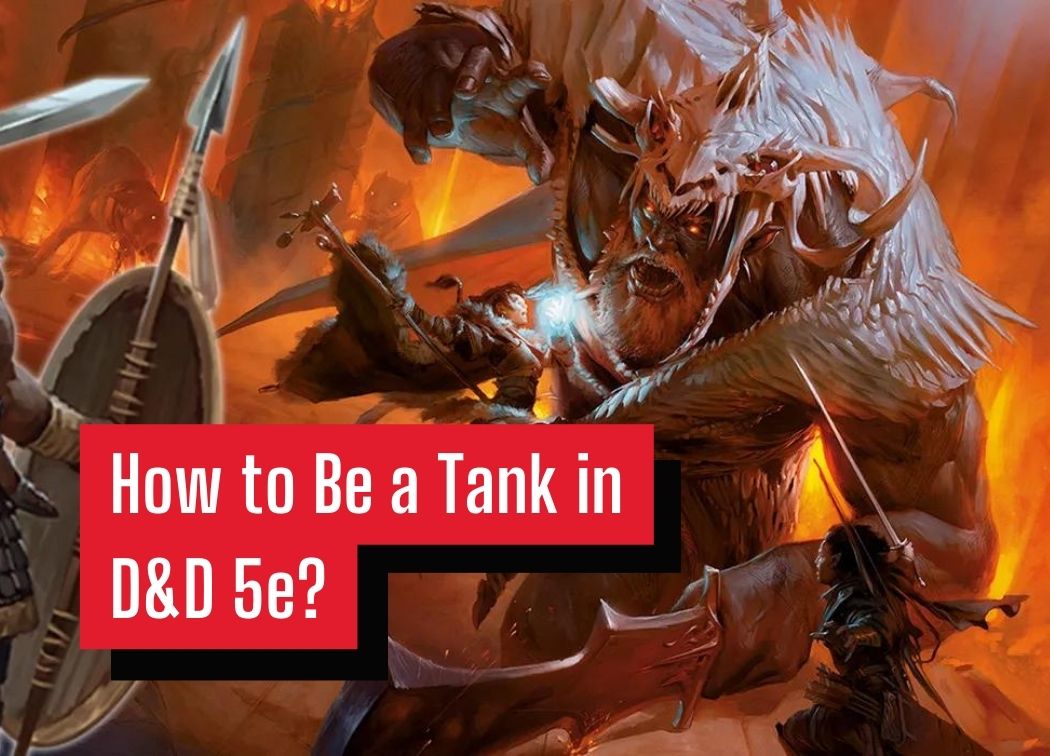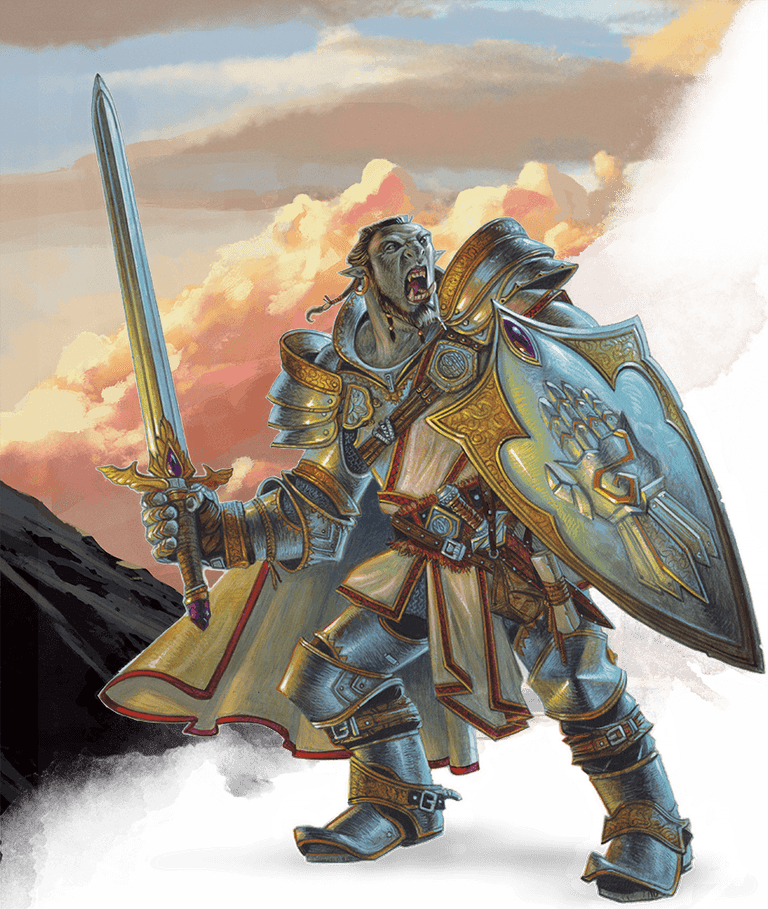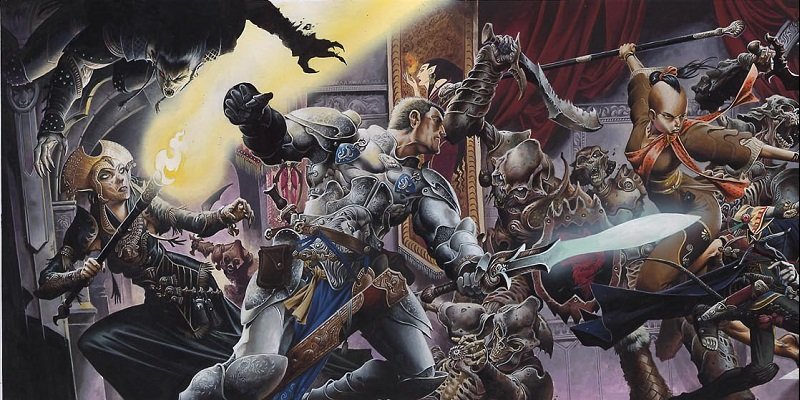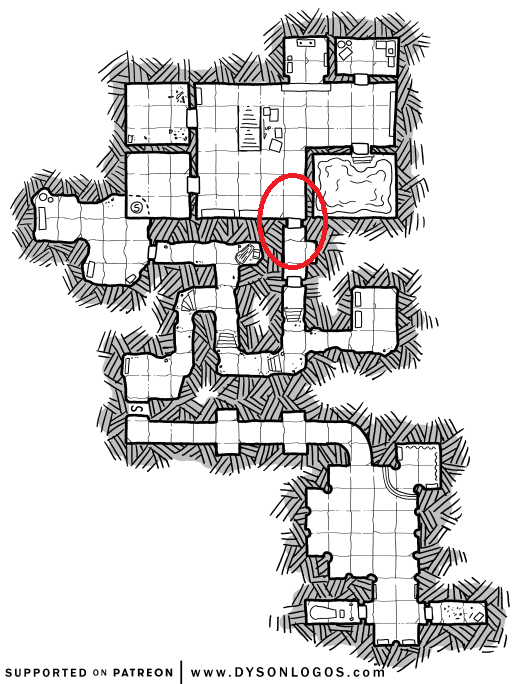How to Be a Tank in D&D 5e?

Being a tank is probably one of my favorite roles in RPGs. I love having that kind of control over a combat encounter, plus it’s fun to be that beefy frontline hero that’s protecting the rest of the group.
I’ve mentioned before that D&D 5e is lax in its “requirements” for party composition. My long-running home game had been playing without a healer for two years before one of them rerolled recently. You can design encounters and campaigns to fit whatever party your players wish to play.
Tanking isn’t necessary, but as I said, many people find it fun.
Let’s learn how can we suit ourselves up in a role that’s a) not required and b) very different to play in a tabletop RPG as compared to a video game.
What is Tanking?
Tanking has always been a role that consists of two parts. The first is a character that can soak a lot of enemy attacks and/or damage. They use themselves to mitigate the damage that their allies might take, even if it hurts them in the process.
This first part is really easy to imagine, plan, and act out in TTRPGs like D&D 5e. You could make a heavily armored fighter that’s got plenty of health. Maybe high AC isn’t your thing? That’s fine, roll up a barbarian and tank using your massive amount of HP and damage resistances.
There are tons of different builds and options to create a tank or tanky character. So many that I doubt I could list them all in this article.
The second part is that tanks have a way of drawing the enemy’s attention to themselves. In video games, tanks tend to have ways to generate threat or force an enemy to attack them.
But D&D doesn’t have a lot of these options at its core. There’s no threat mechanic to force enemies to focus the tank in D&D. There aren’t a lot of taunts or taunt-like mechanics in 5e either. This is the, often overlooked, challenge of building and playing a tank in D&D and most TTRPGs.
How to Tank in D&D
Building Your Character for Survivability
Based on base proficiencies and features alone, barbarians, fighters, and paladins are fantastic choices for a hefty frontline tank build. Choosing any of these classes is setting yourself up with an excellent base class to build your tank with.
Each comes with a solid amount of HP, and the potential to have pretty high AC thanks to Unarmored Defense or heavy armor proficiency. Depending on the decisions you make within the class such as the archetype you choose, you may have a bunch of features that boost your survivability.

Clerics and druids also deserve a mention as they can be super tanky depending on how they’re built. A Circle of the Moon Druid or a War Cleric can tank with the best of them and have tons of spells to choose from to boost their CC, Utility, or Damage output.
Tons of Health and Armor
Anyone can take hits and massive amounts of damage. However, tanks are the ones that can do so and still stand afterward. The surefire way of being certain that you can do that is if you have enough health to sustain a few big hits in combat in case you can’t get healed in between strikes.
Having a good Constitution modifier to give yourself some extra health is going to be a must as a tank. However, it’s going to be just as important to have enough beefy hit dice to have a solid baseline of HP, to begin with. The classes I listed previously all lend themselves to this in one way or another.
That being said, the goal isn’t necessarily to take damage at all as a tank. You just want to have the ability to do so and keep on trucking if you need to.
Damage mitigation is very important and extremely desirable for a tank. High AC is an excellent form of damage mitigation. You waste the enemy’s attack if they miss you, and you don’t take any damage? It’s the perfect outcome!
Some builds and characters sacrifice high AC for other types of passive damage mitigation like the barbarian’s resistance to bludgeoning, piercing, and slashing damage when they rage. AC isn’t the be-all-end-all of a tank.
But, Not Too Much AC!
Too much AC can be more harmful than helpful in some cases.
Let’s put it this way, you’re a behemoth in full plate armor, a shield, and you’ve just cast Shield. You’re at 25 AC. That’s a ridiculous amount of armor for a creature to chew from.
If they’re intelligent creatures they may realize by watching their allies that it’s not worth their time to attack you at all. Instead, they’ll opt to take an opportunity attack from you or disengage to chase one of your less-armored allies. Your godlike AC has just made your job as a tank more difficult.
This is part of why barbarians make such fantastic tanks. They’re naturally able to take and mitigate a ton of damage, all the while still enticing the enemy to keep hitting them.
There’s a point of diminishing returns where super high AC will not help you that much while dissuading enemies from attacking you. Though, the advice in this section does depend a lot on how your DM plays their creatures. If they play them tactically then this outcome is certainly a possibility.
Character Classes and Archetypes
One of my favorite parts about D&D as a player is how many viable build options there are. There are many facets of the game and while some classes and archetypes outshine others, they all have a niche.
Tanks are no exception. If you’re looking to build a frontline behemoth you have a ton of choices. Some of these choices are super obvious like any character that can wear heavy armor or has naturally high HP is probably going to be a good choice at its core.
For example, the Cavalier Fighter which we’ve covered before is an excellent tank right out of the box. They have some solid survivability, and they have mechanics that naturally draw attention to themselves in an encounter.
You don’t have to be a big, burly wall of a character to be a tank though. Consider high Dex classes like monks that can focus more on high AC and crowd control to tank on the frontline. They can’t take a huge hit, necessarily, but they’ll still be able to perform the duties of the tank. Find ways to get yourself some extra HP and you’ll be a formidable tank.
For an example of less conventional-seeming classes being part of a great tank build look no farther than the wizard and sorcerer. They offer up a ton of great options for tanks as part of a multiclass build. Spells like Shield can lend themselves to being excellent defensive cooldowns when you find yourself needing some extra survivability in a pinch!
Some classes and archetypes can create a perfect tank right out of the box. There are also plenty of ways to tweak and tinker with a build to make something unique and feasible. As long as it has health and/or AC, as well as some solid ways of drawing the enemy’s attention, you’re going to do just fine.
Enticing the Enemy to Hit You
Instead, tanks and frontline characters in D&D 5e need to be a bit more creative with how they draw and hold the enemy’s attention to themselves. There will be plenty of times, especially when the best decision for an enemy is to ignore the heavily armored frontline characters and cleave through the spellcasters.
Limit Their Ability to Move Away from You
If you’re the only option that a creature can choose to attack, you’ve done your job well. However, this is going to require you to find ways to limit a creature’s movement.
A simple option that anyone can do is use the Shove action to knock a creature prone. They’ll need to expend half of their movement to get up, limiting their ability to move past your reach.
Another option for the more magically inclined builds is, well, any sort of crowd control spell. A Hold Person and Warcaster feat combo could be pretty devastating. But even simpler than that is Booming Blade. You can force a target to choose between moving and taking some heavy damage, or staying put and dealing with you!

The Sentinel feat is an exceptional option for melee-centric tanks to grab in terms of locking down an enemy. The feat upgrades your opportunity attacks in several ways, but the most prolific of these options is that when a creature is hit by your opportunity attack, its speed is reduced to 0 for the rest of the turn.
This means that you’ll have plenty of opportunities to lock a creature down next to you for an additional turn, preventing it from engaging with another one of your allies and thus giving them some more time to get further away from the enemy.
Now combine Sentinel with Polearm Master, which is even more powerful than I first thought, and you could extend the range and increase the frequency of your opportunity attacks. You become a lockdown machine. Creatures will have a difficult time getting past you or will have to expend more movement to avoid you.
And these few options I’ve mentioned barely scrape the surface! Get creative, find ways to limit your target’s movement, and keep them locked in place with you.
Be the Most Convenient Target to Hit
This strategy can overlap with limiting your target’s ability to move away from you. However, this isn’t always the case. Being the most convenient target is sometimes all you need to be, there’s no extra lockdown required to entice an enemy to hit you.
Find a way to stick out like a sore thumb. This is particularly easy during the earlier portions of an encounter. Rush right towards the enemy in such a way that they’d have to run past you to hit anyone else. At that point, they may as well just make a few swipes at you before they try to move on!
Congratulations, you’ve just tanked. Your allies are safe for at least one round and have time to create more distance between themselves and the enemy.
Being a convenient target is an excellent strategy for low INT and/or WIS opponents. Sure, their attacks aren’t landing on you thanks to your armor, but you’re closest, why would they want to run to the archer when they can all just gang up on you? Take advantage of unintelligent enemies.
Deal Enough Damage to Force Them to Notice You
Another possible strategy for drawing attention to ourselves is to make the enemy regret ignoring you. If you’re both able to tank and able to dish out some solid damage, the enemy may not have a choice but to keep themselves engaged with you.
Traditionally, tanks aren’t exceptional damage dealers. They’re focused on generating threat and using their survivability abilities which both don’t typically coincide with optimal damage dealing. D&D, however, doesn’t have to worry about these types of mechanics. You can be a damage dealer and a tank.
Barbarians are a class that comes to mind with being both a damage dealer and a tank. You can take some massive hits and mitigate them seamlessly, but you’re more than capable of throwing caution to the wind and demolishing an enemy with your two-handed weapon.
Tactical Positioning
Take Advantage of Choke Holds
Choke holds are areas where creatures or your party have to slowly funnel through to get into a room or an area. This funnel essentially breaks the party or the enemy’s formation and allows the other side to control the battlefield for the time being. The map below this paragraph is an example of a chokehold.

If you are in an advantageous position where you can force the enemy to use the chokehold you have made your job as the tank extremely easy. You and the rest of the frontline can plant yourselves at the end of the chokehold and force the enemy to rush at you one at a time. They cannot squeeze past you. They have no choice but to run at you until they, or you, fall.
Taking advantage of terrain, in general, is a rewarding part of D&D’s more tactical combats. As a tank, making use of the terrain to assist in limiting your enemy’s movement is an exceptional skill to have. Chokeholds are the most obvious type of terrain advantages you can take advantage of.
Guard a (Physically) Weaker Ally
Sometimes it’s difficult to find ways to manipulate the enemy’s movements or formation in a way that allows you to tank effectively. In these dire straits, I’d recommend changing up your tactics a bit.
Instead of finding ways of preventing the enemy from reaching your backline, bring yourself to the backline and guard them directly. Stick to an ally with low AC and/or HP and be their bodyguard. They have other strengths in combat and can now focus on acting on those thanks to your protection.
This is a solid strategy for when you can be outmaneuvered or outpaced by a fast enemy. If you can’t beat them, literally join your friends together. Unless they have AoE attacks, of course!
I’ve been a part of this combo before where I played a support sorcerer and frequently had our bear form druid protect me from harm as I buffed and supported him. It’s a fun time for sure.
Create a Buffer Between the Enemy and Your Backline
Let’s face it, there are going to be plenty of encounters where the battlefield doesn’t lend itself towards a carefully crafted tactical display. When in doubt, simply position yourself between the enemy and your allies.
The way I see it, you have two options when you wish to create a buffer.
- If you can reach them, see if you and the other frontline characters can create a type of wall that prevents the enemy from charging straight at your less defensively gifted allies.
- If you can’t reach the enemy, work together to set yourselves up as speedbumps or obstacles for the enemy.
Either way, use Sentinel or your other crowd control abilities to prevent or limit the enemy’s ability to move past you and your frontline. It’s business as usual for you once you’re in position.
The goal isn’t to grab every single one of the enemies. Your goal is to mitigate as much damage from being done to your party as you can. They’re going to have to deal with enemies getting in their face now and then. If they have no way of doing so, that’s on them.
Conclusions
It takes a bit more effort to create and play a tank that makes narrative sense in D&D as opposed to something like WoW where tanking is a crucial part of the game. It’s the most difficult role of the “holy trinity” (Damage, Healer, Tank) to fulfill in TTRPGs as compared to video games.
The majority of the difficulty comes from finding ways to ensure that enemies stick to you and don’t just eat an opportunity attack or disengage to go smack your backline spellcasters around.
Though, that’s not to say that you always need to be the center of attention either. There are times where it’s not possible to, and your character isn’t a failure for not being able to lock every creature in place. Becoming enough of a nuisance that you make things difficult or inconvenient for enemies to target the rest of the party is a success in it of itself.
The issue that most people run into when they build a tank in D&D 5e is that they’re not because tanking or being a frontline character in D&D is very different. You’re not just a meat shield, you have other roles to fulfill as well!
